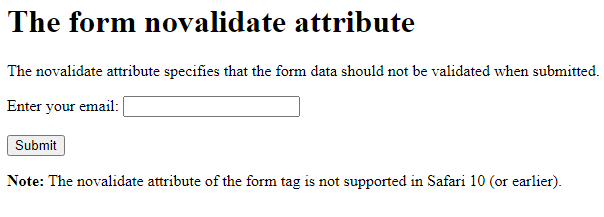This chapter describes the different form* attributes for the HTML <input> element.
The form Attribute
The input form attribute specifies the form the <input> element belongs to.
The value of this attribute must be equal to the id attribute of the <form> element it belongs to.
Example
An input field located outside of the HTML form (but still a part of the form):
<!DOCTYPE html> <html> <body> <h1>The input form attribute</h1> <p>The form attribute specifies the form an input element belongs to.</p> <form action="/action_page.php" id="form1"> <label for="fname">First name:</label> <input type="text" id="fname" name="fname"><br><br> <input type="submit" value="Submit"> </form> <p>The "Last name" field below is outside the form element, but still part of the form.</p> <label for="lname">Last name:</label> <input type="text" id="lname" name="lname" form="form1"> </body> </html>
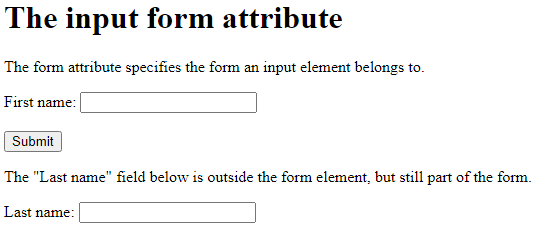
The formaction Attribute
The input formaction attribute specifies the URL of the file that will process the input when the form is submitted.
Note: This attribute overrides the action attribute of the <form> element.
The formaction attribute works with the following input types: submit and image.
Example
An HTML form with two submit buttons, with different actions:
<!DOCTYPE html> <html> <body> <h1>The input formaction attribute</h1> <p>The formaction attribute specifies the URL of a file that will process the input when the form is submitted.</p> <form action="/action_page.php"> <label for="fname">First name:</label> <input type="text" id="fname" name="fname"><br><br> <label for="lname">Last name:</label> <input type="text" id="lname" name="lname"><br><br> <input type="submit" value="Submit"> <input type="submit" formaction="/action_page2.php" value="Submit as Admin"> </form> </body> </html>
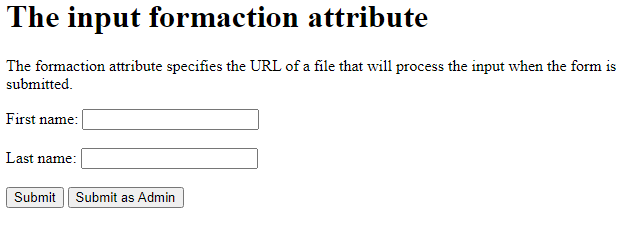
The formenctype Attribute
The input formenctype attribute specifies how the form-data should be encoded when submitted (only for forms with method=”post”).
Note: This attribute overrides the enctype attribute of the <form> element.
The formenctype attribute works with the following input types: submit and image.
Example
A form with two submit buttons. The first sends the form-data with default encoding, the second sends the form-data encoded as “multipart/form-data”:
<!DOCTYPE html> <html> <body> <h1>The input formenctype attribute</h1> <p>The formenctype attribute specifies how the form data should be encoded when submitted.</p> <form action="/action_page_binary.asp" method="post"> <label for="fname">First name:</label> <input type="text" id="fname" name="fname"><br><br> <input type="submit" value="Submit"> <input type="submit" formenctype="multipart/form-data" value="Submit as Multipart/form-data"> </form> </body> </html>

The formmethod Attribute
The input formmethod attribute defines the HTTP method for sending form-data to the action URL.
Note: This attribute overrides the method attribute of the <form> element.
The formmethod attribute works with the following input types: submit and image.
The form-data can be sent as URL variables (method=”get”) or as an HTTP post transaction (method=”post”).
Notes on the “get” method:
- This method appends the form-data to the URL in name/value pairs
- This method is useful for form submissions where a user want to bookmark the result
- There is a limit to how much data you can place in a URL (varies between browsers), therefore, you cannot be sure that all of the form-data will be correctly transferred
- Never use the “get” method to pass sensitive information! (password or other sensitive information will be visible in the browser’s address bar)
Notes on the “post” method:
- This method sends the form-data as an HTTP post transaction
- Form submissions with the “post” method cannot be bookmarked
- The “post” method is more robust and secure than “get”, and “post” does not have size limitations
Example
A form with two submit buttons. The first sends the form-data with method=”get”. The second sends the form-data with method=”post”:
<!DOCTYPE html> <html> <body> <h1>The input formmethod Attribute</h1> <p>The formmethod attribute defines the HTTP method for sending form-data to the action URL.</p> <form action="/action_page.php" method="get" target="_blank"> <label for="fname">First name:</label> <input type="text" id="fname" name="fname"><br><br> <label for="lname">Last name:</label> <input type="text" id="lname" name="lname"><br><br> <input type="submit" value="Submit using GET"> <input type="submit" formmethod="post" value="Submit using POST"> </form> </body> </html>

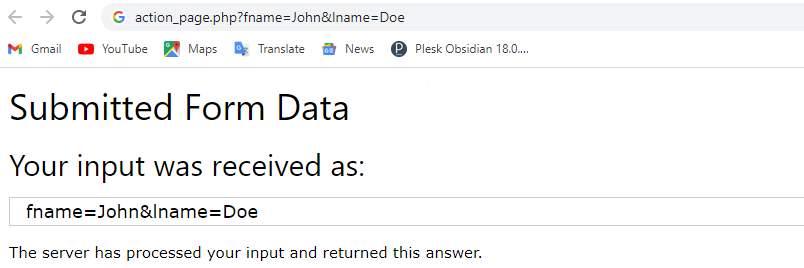

The formtarget Attribute
The input formtarget attribute specifies a name or a keyword that indicates where to display the response that is received after submitting the form.
Note: This attribute overrides the target attribute of the <form> element.
The formtarget attribute works with the following input types: submit and image.
Example
A form with two submit buttons, with different target windows:
<!DOCTYPE html> <html> <body> <h1>The input formtarget attribute</h1> <p>The formtarget attribute specifies a name or a keyword that indicates where to display the response that is received after submitting the form.</p> <form action="/action_page.php"> <label for="fname">First name:</label> <input type="text" id="fname" name="fname"><br><br> <label for="lname">Last name:</label> <input type="text" id="lname" name="lname"><br><br> <input type="submit" value="Submit"> <input type="submit" formtarget="_blank" value="Submit to a new window/tab"> </form> </body> </html>
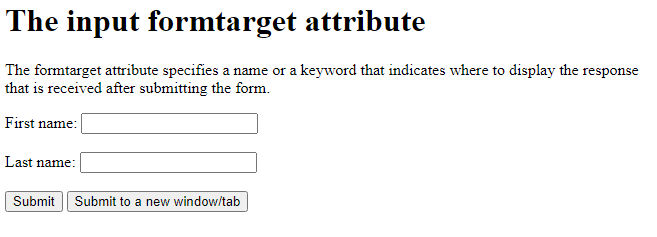
The formnovalidate Attribute
The input formnovalidate attribute specifies that an <input> element should not be validated when submitted.
Note: This attribute overrides the novalidate attribute of the <form> element.
The formnovalidate attribute works with the following input types: submit.
Example
A form with two submit buttons (with and without validation):
<!DOCTYPE html> <html> <body> <h1>The input formnovalidate attribute</h1> <form action="/action_page.php"> <label for="email">Enter your email:</label> <input type="email" id="email" name="email" required><br><br> <input type="submit" value="Submit"> <input type="submit" formnovalidate="formnovalidate" value="Submit without validation" </form> <p><strong>Note:</strong> The formnovalidate attribute of the input tag is not supported in Safari 10 (or earlier).</p> </body> </html>

The novalidate Attribute
The novalidate attribute is a <form> attribute.
When present, novalidate specifies that all of the form-data should not be validated when submitted.
Example
Specify that no form-data should be validated on submit:
<!DOCTYPE html> <html> <body> <h1>The form novalidate attribute</h1> <p>The novalidate attribute specifies that the form data should not be validated when submitted.</p> <form action="/action_page.php" novalidate> <label for="email">Enter your email:</label> <input type="email" id="email" name="email" required><br><br> <input type="submit" value="Submit"> </form> <p><strong>Note:</strong> The novalidate attribute of the form tag is not supported in Safari 10 (or earlier).</p> </body> </html>
